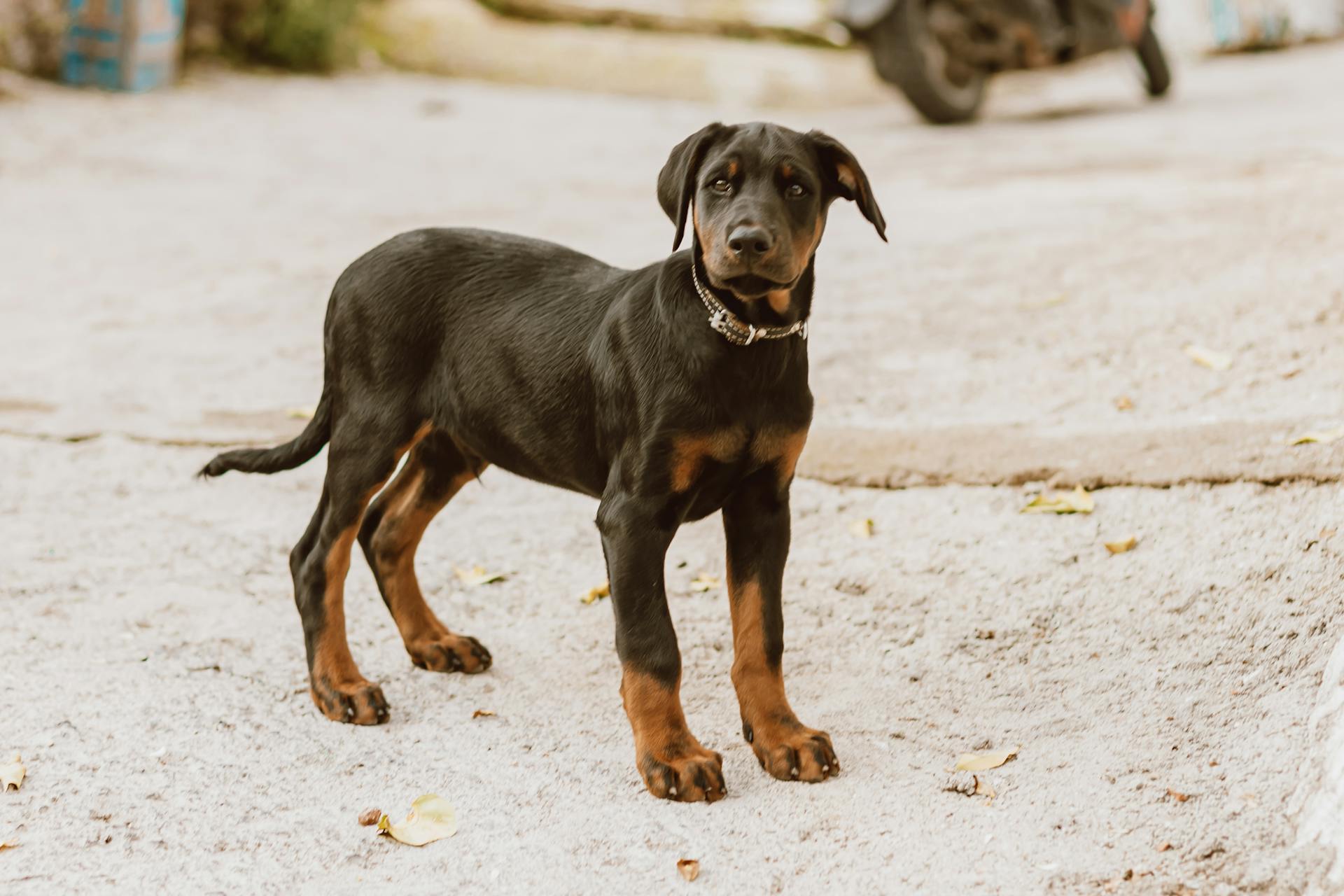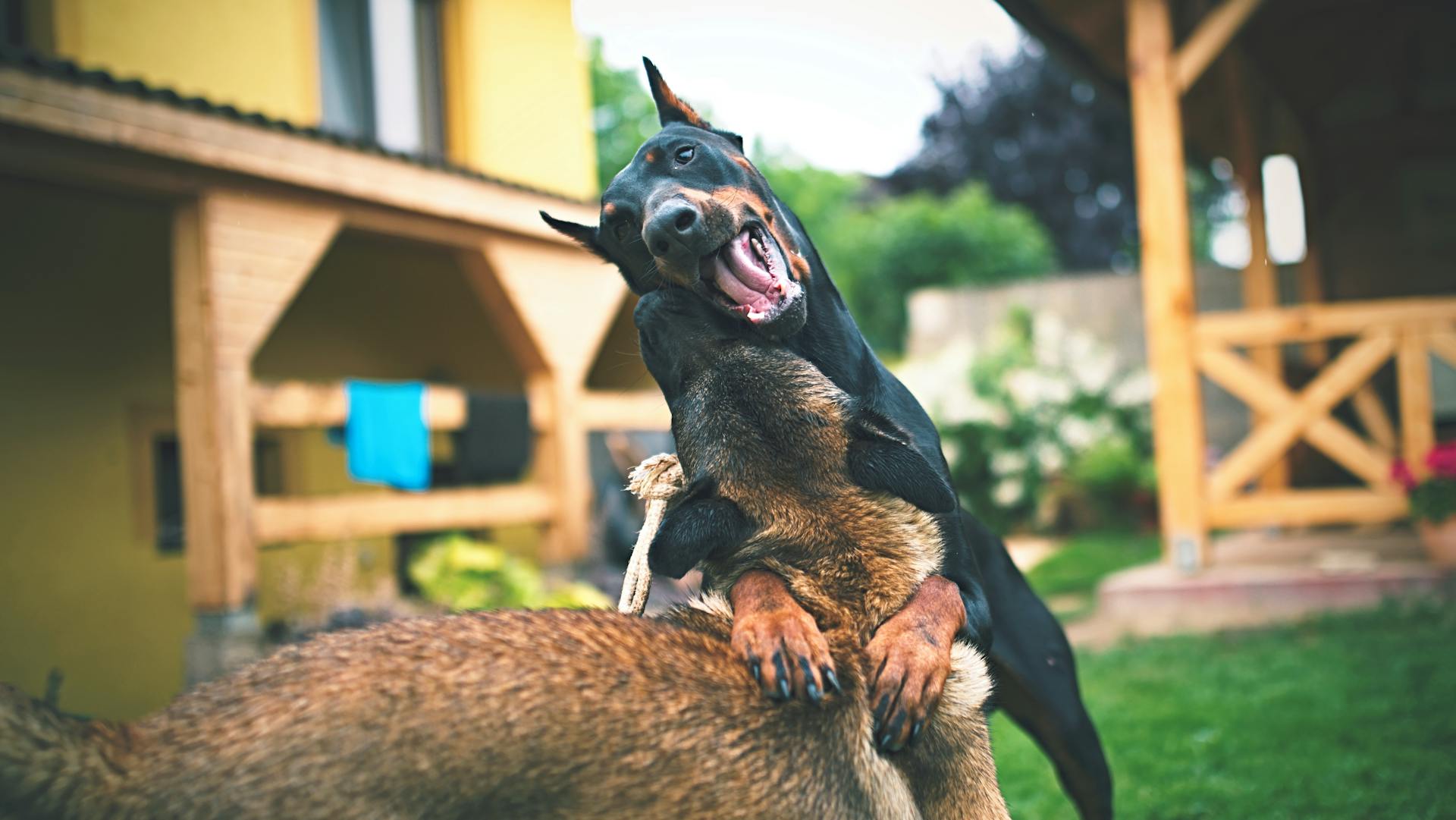
Doberman Pinschers are known for their sleek and athletic build, but their weight can vary significantly depending on their age, sex, and lineage.
At birth, a Doberman Pinscher puppy typically weighs between 8 and 12 ounces.
As they grow, Doberman Pinschers can reach a maximum weight of 80 pounds for males and 60 pounds for females.
Regular exercise and a balanced diet are crucial for maintaining a healthy weight in Doberman Pinschers.
Health and Care
Doberman Pinschers are prone to joint and bone problems due to their large size, so regular exercise, a balanced diet, and maintaining a healthy weight can help reduce the risk of these issues. This includes hip dysplasia and osteoarthritis, which can cause pain, lameness, and mobility issues.
Feeding multiple small meals throughout the day can help reduce the risk of bloat, a life-threatening condition that can affect deep-chested breeds like Dobermans. This is especially important after exercise or playtime.
Related reading: Doberman Pinscher Health Issues
Doberman Pinschers are also prone to heart conditions, such as dilated cardiomyopathy (DCM), which affects the heart muscle, causing it to become weak and enlarged. Regular veterinary check-ups and a heart-healthy diet can help monitor and manage these conditions.
Maintaining a healthy weight is crucial for Dobermans, as obesity can lead to various health issues, including joint problems, diabetes, and heart disease. Providing a balanced diet, portion control, and regular exercise are essential for keeping your Doberman at a healthy weight.
Here are some essential care tips to ensure your Doberman stays healthy and happy:
- Provide a high-quality, balanced diet that meets the nutritional needs of your Doberman.
- Aim for at least one to two hours of exercise per day, including walks, runs, playtime, and interactive toys.
- Regular brushing with a soft-bristle brush helps remove loose hair and keep their coat healthy.
- Regular nail trims, ear cleaning, and teeth brushing are essential parts of their grooming routine.
- Start training and socializing your Doberman from a young age to ensure they grow into well-behaved and confident adults.
By following these care tips and staying on top of regular veterinary check-ups, you can help your Doberman live a happy and fulfilling life.
Diet and Nutrition
Feeding your Doberman two meals a day can help prevent gas and bloating, which can become a medical emergency if the stomach twists to cut off the blood supply.
The amount of dry dog food your Doberman needs will depend on their size, activity level, age, and other factors, and can range up to three and a half cups per day.
Monitoring your Doberman's weight is crucial, as obesity can reduce their lifespan and contribute to other health conditions.
Discussing your dog's nutritional needs with your veterinarian will give you tailored recommendations for your pet's specific needs.
Curious to learn more? Check out: Doberman Pinscher Exercise Needs
Growth and Size
A Doberman Pinscher's growth rate is a fascinating topic, and understanding it can help you care for your furry friend. The average growth rate of a Doberman puppy is roughly 10 pounds of weight gain for every month of age.
This rule of thumb is generally fairly accurate for male Dobermans until about seven or eight months of age, after which their weight gain rate begins leveling off. For female Dobermans, you can use the same rule if you subtract about 5 pounds from that weight.
To give you a better idea, here's a rough estimate of a Doberman's weight at different ages:
Keep in mind that this is just a rough estimate, and the weight of Dobermans varies greatly. If your dog falls outside of the shaded region of this chart at any given stage of growth, it doesn't necessarily mean they're unhealthy.
Health Risks
Doberman Pinschers are prone to several health risks that can be linked to their weight and size. Brushing their teeth daily can prevent periodontal disease. Regular exercise, a balanced diet, and maintaining a healthy weight can help reduce the risk of joint and bone problems such as hip dysplasia and osteoarthritis.
Larger Dobermans are more susceptible to certain health issues, including dilated cardiomyopathy (DCM), a weakening of the heart muscle. They also have a lower tolerance to heat, making hot weather more challenging for them. Overweight Dobermans are at an increased risk for various types of cancer.
A Doberman's size can impact their overall health and well-being, making them more prone to joint and bone problems. Regular veterinary check-ups and a heart-healthy diet can help monitor and manage heart conditions such as DCM.
Here are some common health risks associated with Doberman Pinschers and their size:
Maintaining a healthy weight is essential for Dobermans, as obesity can lead to various health issues, including joint problems, diabetes, and heart disease. Providing a balanced diet, portion control, and regular exercise are crucial for keeping your Doberman at a healthy weight.
Caring for Large Breeds
Caring for a large breed like the Doberman Pinscher requires attention to their specific needs. Providing a high-quality, balanced diet that meets their nutritional needs is crucial.
Consult with your veterinarian to determine the right type and amount of food for your dog based on their age, weight, and activity level. Avoid overfeeding and monitor their weight regularly to prevent obesity.
Dobermans are an energetic breed that requires regular exercise to keep them physically and mentally stimulated. Aim for at least one to two hours of exercise per day.
Their short coat is relatively low-maintenance, but regular brushing with a soft-bristle brush helps remove loose hair and keep their coat healthy.
Regular veterinary care is essential for monitoring your Doberman's health and catching any potential issues early on. Vaccinations, parasite prevention, dental care, and regular screenings are all part of maintaining their overall well-being.
Here are some key things to keep in mind when caring for a large breed Doberman:
- Feed a high-quality diet appropriate for their age.
- Exercise your dog regularly, but don't overdo it at first.
- Clean their ears weekly, even as a puppy.
- Brush their coat as needed, at least weekly.
- Keep their diet consistent and don't give them people food.
Dobermans are sensitive dogs and don't do well with harsh training methods or punishment. Always end training on a positive note.
By providing your Doberman Pinscher with proper care, attention, and a loving environment, you can ensure they live a happy and fulfilling life.
You might like: Doberman Pinscher Training
Size and Weight Prediction
Predicting the size and weight of your Doberman Pinscher can be a fun and exciting process. Modern at-home DNA health tests, such as the Embark DNA test kits, can give you an incredibly deep look into your dog's genetic health, including their adult size, with a high level of accuracy.
The size of your Doberman's parents is also a good indicator of their genetics in terms of growth. If both parents are large and heavy-boned, it's more likely that their offspring will also be on the larger side. You can also compare your puppy to its littermates to help predict how large they will get.
Another way to predict your Doberman's size is to look at their paw size. The general thinking is that larger paws are needed to support a heavier dog, so it's a good indicator of your dog's genetics in terms of size.
Related reading: Size of Doberman Pinscher
Breed Size Comparison
The Doberman Pinscher is a larger breed, standing at a height of 24 to 28 inches.
Labradors are generally smaller and lighter, weighing between 55 to 80 pounds.
German Shepherds can be similar in size to Dobermans, but they have a more substantial bone structure and a denser coat.
The Great Dane is significantly taller and heavier, weighing between 110 to 175 pounds and reaching heights of 28 to 32 inches.
Doberman Pinschers weigh between 65 to 100 pounds, which is a significant range.
Individual dogs may vary in size, but these general averages give you an idea of what to expect.
Considering size is just one aspect, it's essential to think about temperament, energy levels, and exercise requirements when choosing a breed.
The Doberman Pinscher's size is relatively consistent, with a height range of 24 to 28 inches.
On a similar theme: European Doberman Pinscher Size
Puppy Growth Prediction
Predicting your Doberman puppy's adult size can be a fun and exciting experience. Genetics play a significant role in determining the size of a dog, as they inherit traits from their parents. If both parents are large and heavy-boned, it's more likely that their offspring will also be on the larger side.
One way to predict your Doberman puppy's adult size is to use DNA testing. Modern at-home DNA health tests, such as the Embark DNA test kits, can give you an incredibly deep look into your dog's genetic health, including their adult size. These tests test for five specific genes that are known to influence about 85% of the variation in their adult size.
Looking at the size of your Doberman puppy's parents is also a good indicator of their genetics in terms of growth. You can then compare your puppy to its littermates to help predict how large they will get. If they're the largest in the litter, it means your dog will likely be as big (or bigger) than its parents.
Another way to predict your Doberman puppy's adult size is to use the "paw size" method. The general thinking is that larger paws are needed to support a heavier dog, so if your Doberman's paws are larger, they will likely be bigger as an adult.
You can also use the "4-month weight" method to predict your Doberman puppy's adult size. Take their weight at 4 months old (or about 16 weeks) and multiply it by two, then add 5 pounds. This will give you a rough estimate of their adult weight.
Intriguing read: Doberman Pinscher 4 Months Old
Here's a rough estimate of a Doberman puppy's weight gain per month:
Keep in mind that this is just a rough estimate, and the weight of Dobermans can vary greatly. It's always best to consult with a qualified veterinarian if you have any concerns about your dog's weight.
American and European Doberman Pinschers
American and European Doberman Pinschers have distinct physical characteristics that affect their weight. The American Doberman Pinscher is leaner than its European counterpart.
The AKC lists the breed standard weights for the American Doberman Pinscher as 75-100 pounds for males and 60-90 pounds for females. In contrast, the European Doberman tends to be bulkier and more muscular.
The European Doberman's bone structure is thicker, which contributes to their generally higher weight. The FCI defines the breed standard weights for the European Doberman as about 88-99 pounds for males and 71-77 pounds for females.
Here's a comparison of the breed standard weights for both types of Doberman Pinschers:
American
The American Doberman Pinscher is a leaner breed compared to its European counterpart. They generally weigh less, with the AKC breed standard listing males as weighing between 75 – 100 pounds.
According to the AKC, American Doberman Pinscher females typically weigh between 60 – 90 pounds. This weight range can vary, but it's a good starting point for understanding the breed's size.
A unique perspective: Doberman Pinscher Standard
European
The European Doberman is a bit bulkier and more muscular than its American counterpart, with a blockier head and snout, and a broad chest. This results in a generally higher weight.
Their bone structure is thicker, which is most apparent in their build. European Dobermans typically weigh more than American Dobermans.
According to the Federation Cynologique Internationale (FCI), the breed standard weights for the European Doberman are as follows:
The FCI's weight range for the European Doberman is narrower than the breed standard for the American Doberman.
Frequently Asked Questions
What is the heaviest Doberman?
The maximum weight for a Doberman is around 100lbs, which is the upper limit of the breed standard.
Sources
- https://www.dailypaws.com/dogs-puppies/dog-breeds/doberman-pinscher
- https://www.thesprucepets.com/doberman-pinscher-dog-breed-profile-1117961
- https://www.thepethealthclinic.com/client-resources/breed-info/doberman-pinscher/
- https://www.dobermanplanet.com/doberman-weight-growth-curve-and-averages/
- https://blog.tryfi.com/doberman-pinscher-size-features/
Featured Images: pexels.com

